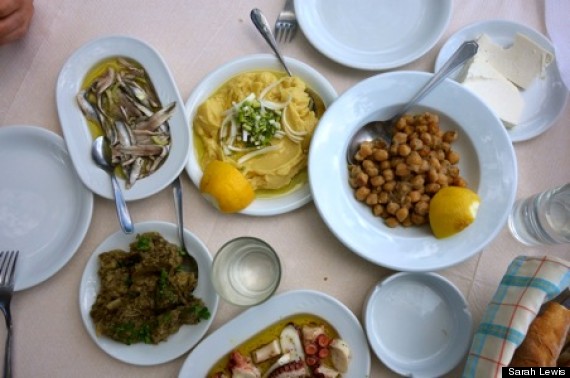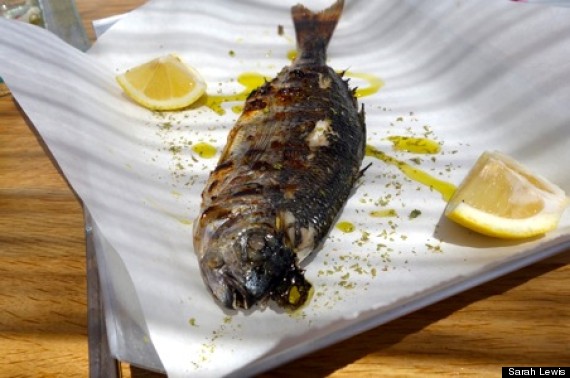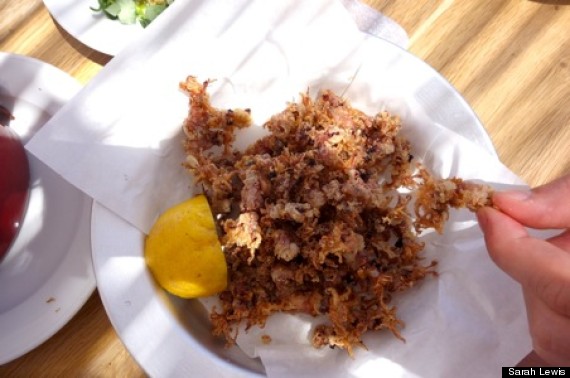Every summer, urban Grecians migrate from the mainland to many of the country's mythical islands. Here, away from the chaos of the cities, Greeks have mastered one of the most enviable arts of Mediterranean living. At the heart of this art is a late afternoon lunch, taken after a soothing wade in the shallows, an invigorating dive from the rocks, or hours lost amongst backgammon, iced coffee, olive, stucco, and bougainvillea.
Under the speckled shade of the tamarix trees, with a view of that Aegean blue, friends and family gather to enjoy leisurely hours of familiar recipes, made with simple but native ingredients.

Of course the traditional Greek kitchen--from Mount Pelion to the Peleponese, the Cyclades to Crete--is far richer than this short summary. That being said, the purest Greek pleasures are not to be researched, foraged, or sweated for. Instead, decent instinct and local inquiry, paired with patience and a well-earned appetite, should more than prepare one for the ultimate Greek feast. Below are a couple of true local culinary pointers.
Most tavernas are both pleasantly predictable and infinitely personal, making these spots a well-kept secret from outsiders. Proximity to a fishing port or vegetable garden, as well as the homemade flavor of a meal from grandma's kitchen are both surefire signs of an authentic taverna. Other characteristics include the superior skills of a Cretencook, and menus that champion roast potatoes over the ubiquitous french fries, for example. While tavernas share similarities, each dining experience is entirely unique; so the best I can offer is my well-trained self as an example...

After choosing a breezy table, I order water and horatiki salata, leave my belongings, and jump from the nearest dock for a final swim. By the time I am dry, a perfect abundance of ripe tomatoes, sweet onions, cucumber, olives, and feta (mizithra in Sifnos) is moseying its way to the table. From here I order fava, a velvety yellow split pea puree topped with chopped red onion and olive oil. I take taramosolata, a luscious mousse of white (not hot pink) caviar, and if they have beet leaves, I take them with a side of skordalia, a biting whip of potato and raw garlic. In the spring, the land is soft with an impressive array of horta or wild greens, sauteed for seconds and dressed only with lemon--by summer, I look for vlita, or abelofasoula.
For balance, I take whatever fried bites are available, which are meatball-like mashes of either zucchini, chickpeas, or cheese.
Instead of moussaka I'll order papoutsakia, an entire eggplant stuffed with ground beef and tomato, frosted with bechamel, and baked. For legumes, ask for broad beans, stewed with tomato, garlic, and honey, while for meat I take chicken, whole and slow roasted in a nest of fragrant, lemony potatoes.

To drink, ask for a pint of Fix beer or an improvised spritz, made with house wine and siroti. And for desert? Usually watermelon or karpusi, though cookies (sweet and chewy, or crumbly and nutty) can usually be expected with the bill.
Later, when the sun has gone down and hunger returns, skip the taverna for a kafe neo and indulge in a Greek aperitivo called mezze. Strong spirits like ouzo and raki are enjoyed next to plates, traditionally prepared at the owner's home (by colloquial definition, a kafe neo does not have its own kitchen). Look for veal meatballs spiced with anise, called keftedakia, beatroots tossed with parsley and yogurt, marinated pork smoked with aromatics, called apaki, or local olives, dried fruits, and cheese. Traditionally, ouzo is drunk with fish, like marinated octopus or pickled anchovies. If close to the sea, ask for kidonia, a local clam, which is cracked alive at the table, drowned in lemon, and downed. For desert, enjoy single spoons of candied fruits, like baby limes, unripened pistachios, pears, cherries, or figs, called glyko tou koutaliou, or spoon sweets.
Afterward, if late night dancing leaves you hungry, there is no better hour for souvlaki. But purists beware! Pay attention when you order; if you get one with "everything," a pita wrapped gyro may come dressed in some unfortunate accessories, from curry and ketchup to cheeze wiz and french fries. --By Sarah Lewis

Want more from Fodor's?
15 UNESCO Sites to See While You Still Can
4 US Road Trips to Take Before you Die
10 Coolest Attractions in Bangkok
Undiscovered Asia: The 5 Places to Go Next